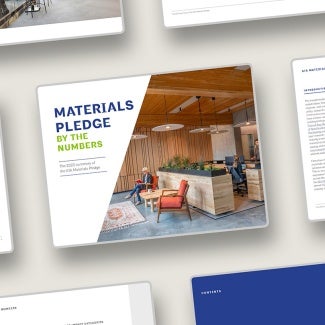Four ways architects can fight climate change
Time’s running out to slow down global warming. With climate change-related natural disasters increasing in size and frequency, the role architects play in climate action becomes more critical by the day

Architects’ role in climate action
Wildfires. Superstorms. Drought, floods, mass extinction, and disease. This isn’t a sci-fi apocalypse, it’s the nightly news.
Scientists warn that the consequences of a warming planet already plague us, and we have just a few years to make a difference before things get far worse. We could hit the 1.5°C warming threshold as early as 2030, according to the latest report from the Intergovernmental Panel on Climate Change (IPCC). After that, things start to get dire, with more extreme temperatures around the world, heavier precipitation in some places, and increased risk of drought in others. At the recent Global Climate Action Summit, speakers highlighted the importance of bending our emissions curve sharply downward by 2020.
But there’s hope. Buildings are a major contributor to global warming, and we can make a huge impact by changing how we practice architecture. If we don’t—and soon—the effects will be drastic and irreversible.
It’s clear where we stand, now here’s how you can continue to help.
1. Join the 2030 Commitment
AIA has been working for more than a decade on the issue of climate change, actively helping our members become part of the solution. We have backed the 2030 Challenge since its inception in 2006 and in 2009, we launched the 2030 Commitment to help bring the goals into realistic focus.
The operational carbon of buildings—meaning the emissions caused by HVAC, lighting, and other energy-consuming operations—is the biggest problem to tackle. Architects can lead the way with envelope improvements and other system efficiencies to get those emissions down.
In 2017 alone, architects tracking building energy use reduced their predicted carbon emissions by 17.8 million metric tons of CO2 per year. That’s like planting 21 million acres of forest.
Who’s tracking that energy use, and how? More than 500 firms have signed on to the AIA 2030 Commitment, which supports the 2030 Challenge. Joining the commitment is the easiest way to measure your firm-wide progress on reducing energy use and carbon emissions. Register your firm today through the 2030 Design Data Exchange (DDx). For more on how to meet your firm’s goals, explore the AIA+2030 online education series.
2. Adapt & retrofit existing buildings
It’s vital to focus on the operating energy of new construction. But the vast majority of our building stock already exists—and it needs our help. “The greenest building is one that’s already built,” according to Carl Elefante, FAIA, 2018 AIA President. Demolition and new construction both come with a big carbon footprint. Meanwhile, existing buildings often offer charms and amenities that cannot be achieved affordably with new construction.
For buildings that are already in place, deep energy retrofits are a critical need that architects can help meet. “Retrofitting existing buildings to meet high-performance standards is the most effective strategy for reducing near- and mid-term carbon emissions,” says Elefante.
These upgrades—especially when they leverage older buildings’ passive design strategies—have another benefit, too: improving resilience to hazards. Before deciding to invest in an existing building, first conduct a vulnerability assessment to ensure the building is not at high risk from wildfires, sea-level rise, or other climate impacts.
3. Select carbon-smart materials
Manufacturing steel and concrete results in massive global warming impact. The carbon footprint represented by its materials is referred to as a building’s embodied carbon.
Reducing embodied carbon over the next few years is a particularly important strategy because it will help us meet large scale emission reduction targets recommended by global organizations. As discussed above, the simplest and most effective way to slash embodied carbon in the short-term is to choose an existing building.
To cut embodied carbon in new construction, we need to reduce our use of the highest-emitting materials like concrete, steel, aluminum, and foam insulation. We can get part of the way there by optimizing systems to ensure we aren’t specifying more material than is needed for the job. We can also choose alternatives like those recommended in Architecture 2030's Carbon Smart Materials Palette.
4. Pursue renewable energy
After a building has achieved ultra-low energy consumption through smart design for building efficiency, it’s time to consider offsetting the rest of its energy use with renewables. When you bring up renewable energy, many people immediately think of solar panels, but they should take second priority to low-cost and no-cost efficiency and operational solutions. Start by talking to your clients about low-carbon energy procurement and green energy contracts. Understanding available renewables and how to efficiently use them in your buildings—that’s what’s ultimately needed to bring operational carbon to zero as envisioned by the 2030 Commitment.
Moving forward as a profession
While we won’t be able to fully reverse the impacts of climate change, we can guide our design teams and clients on climate-adaptive strategies. Whether you’re updating an existing building or constructing a new one, AIA has several resources available to help you create sustainable structures that will last for future generations, including our resilience and adaptation education courses.
Next time you take on a new project, start with our primers on building lifecycle assessments and energy modeling. Architects have a responsibility to advocate for sustainable design, which can be better for the environment, better for people, and beautiful at the same time. Recipients of the AIA COTE® Top Ten and AIA COTE® Top Ten for Students design awards exemplify how truly great architecture and sustainability go hand in hand. Together, we can create more inspiring buildings like these.
With only a few years to go until 2030, it’s time to join the movement if you haven’t already. It’s by working together as a profession that architects can make a difference for the planet and for humanity.
For more, visit our climate action page and read the most recent 2030 by the numbers report.
Paula Melton is editorial director at BuildingGreen.



